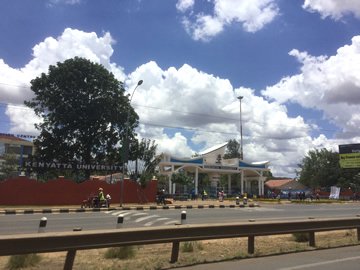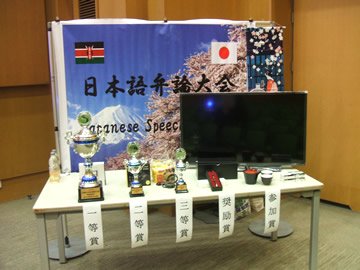Connecting the Dots as a First Step
Kenyatta University
TAKAHASHI Tomoya
Although there are 54 countries in Africa, only two— Egypt and Kenya—have a Japanese-Language Specialist (hereinafter “Specialist”) dispatched from the Japan Foundation. Kenya is therefore the only sub-Saharan nation in the south of Sahara Desert to have Specialist available.
The work of Specialists in Kenya is much broader than just supporting the Japanese-language course at Kenyatta University (hereinafter “KU”), the accepting institution. It also includes providing assistance for Japanese-language education and teachers in Kenya, and helping to form a Japanese-language education network across the whole of the East African region.
KU Students
The KU main campus is in the suburbs of the capital Nairobi, approximately 20 km northeast of the city center. It is one of the leading universities of Kenya, with approximately 70,000 students. The base for the Japanese-language course is the free elective introduction to Japanese course. It is available to all enrolled undergraduate students free of charge. After completing the free elective subject, students can proceed to a minor subject in Japanese.
The introduction to Japanese class brings together various students from a variety of university departments. There are three hours of classes per week, but many students have to drop out of classes because the timetable clashes with the classes of their major subject, or they can only attend by arriving late or leaving early. Even given this situation, I hope it will be possible to run a class where people who have never met each other before can come together to continue their classes each week, deepening the bonds not only between teachers and students, but also between the students themselves, so that they encourage each other to continue learning Japanese.
Incidentally, if you were shown a blank map of Africa, I wonder how many of you could say with confidence where Kenya is located? Just as Japanese people only have limited knowledge of Africa, the information that the KU students have about Japan is very fragmented. Most students would not know what a sumo wrestler does, even if they saw a picture of one, and have no idea what words like kabuki and ninja mean when they hear them. This is why classes at KU require the use of audiovisual educational teaching materials.

Main entrance to Kenyatta University
Japanese Speech Contest and the Conference on Japanese-Language Education
It is vital for the Specialist to also work together with the Japanese embassy and the Japanese Language Teachers’ Association of Kenya (hereinafter “JALTAK”). In March 2017 the 10th Japanese Speech Contest was held jointly by the embassy and JALTAK and it is usually the case each year that the Specialists act as the chair of the judging committee. This year many of the contestants had just started learning Japanese and were at the stage of aiming to achieve N5 level of the Japanese-Language Proficiency Test (JLPT). Even so, they all bravely delivered their prepared speeches to an audience of nearly 200 people, who had gathered in the embassy’s multi-purpose hall. You can see video clips of the contest on this link below.
Click here to see video clips from the contest.
https://www.youtube.com/watch?v=buSbjk3ZuQA

10th Japanese Language Speech Contest prizes
For two days starting on the day after the Japanese speech contest, JALTAK hosted the 5th Kenya Conference on Japanese-Language Education at KU, which engaged in planning and operations, led mainly by the Specialist. JICA volunteers working as Japanese-language teachers in Sudan and Madagascar were invited to the conference as speakers. Also, the Nairobi Japanese School and a local primary school were able to give their first presentation on initiatives to provide Japanese-language instruction. As there is no professional training program for Japanese or Japanese-language education in Kenya, even if people want to start studying Japanese, or continue their studies, it is very difficult for members of the general public to find an appropriate educational institution. Given this situation, I hope that events such as the Japanese speech contest and the Conference on Japanese-Language Education will help to bring together people who have never had contact with each other before, but who are all trying to engage in Japanese-language learning and education in a process of trial and error, and help them grow as a community.
Japanese-Language Education in East Africa
Working to support the creation of cross-border networks is also an important part of the Specialist’s job. As the predecessor wrote in last year’s report, the 4th East Africa Conference on Japanese-Language Education (hereinafter “EAC”) was held in Madagascar for the first time last year. The fifth conference is scheduled to be held in Madagascar once again this year. Just like Kenya, Madagascar is a country where Japanese-language education is flourishing.
The EAC offers a unique opportunity to hear reports from all the countries of East Africa, share challenges facing Japanese-language education in the region, and explore future prospects together face-to-face. Outside of Kenya and Madagascar there are no teachers’ associations in any other country and Japanese-language educational institutions are only scattered sporadically through the region. We are preparing for this year’s conference with hope for the future, seeking to ensure that the EAC functions as a network that encompasses all countries of the region, and is also a gathering that satisfies the teachers who are struggling in isolation to teach Japanese language.
- What We Do Top
- Arts and Cultural Exchange [Culture]
- Japanese-Language Education Overseas [Language]
- Japanese-Language Education Overseas [Language] Top
- Learn Japanese-language
- Teach Japanese-language
- Take Japanese-Language Test
- Know about Japanese-language education abroad
- The Japanese-Language Institute, Urawa
- The Japanese-Language Institute, Kansai
- Japanese-Language Programs for Foreign Specified Skilled Worker Candidates
- Japanese Language Education for Japanese Children Resident Overseas and for the Descendants of Migrants
- Archives
- Japanese Studies and Global Partnerships [Dialogue]
- JF digital collection
- Other Programs / Programs to Commemorate Exchange Year
- Awards and Prizes
- Publications
